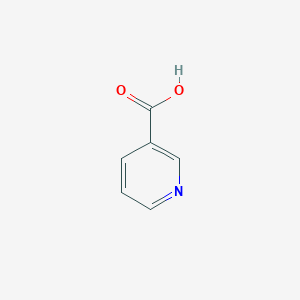| General Information of MET (ID: META00436) |
| Name |
Nicotinic acid
|
| Synonyms |
Click to Show/Hide Synonyms of This Metabolite
3 Pyridinecarboxylic acid; 3-Carboxylpyridine; 3-Carboxypyridine; 3-Pyridinecarboxylate; 3-Pyridinecarboxylic acid; 3-Pyridylcarboxylate; 3-Pyridylcarboxylic acid; Acide nicotinique; Acido nicotinico; Acidum nicotinicum; Akotin; Aluminum salt, niacin; Anti-pellagra vitamin; Apelagrin; Daskil; Efacin; Enduracin; Hydrochloride, niacin; Induracin; Linic; Lithium nicotinate; Niac; Niacin; Niacin aluminum salt; Niacin ammonium salt; Niacin calcium salt; Niacin cobalt (2+) salt; Niacin copper (2+) salt; Niacin hydrochloride; Niacin iron (2+) salt; Niacin lithium salt; Niacin lithium salt, hemihydrate; Niacin magnesium salt; Niacin manganese (2+) salt; Niacin potassium salt; Niacin sodium salt; Niacin tartrate; Niacin tosylate; Niacin zinc salt; Niacine; Niacor; Niaspan; Nicacid; Nicamin; Nicangin; Nico 400; Nico-400; Nico-span; Nico400; Nicobid; Nicocap; Nicodelmine; Nicolar; Niconacid; Nicosan 3; Nicotinate; Nicotinate, lithium; Nicotinipca; Nicyl; Nikotinsaeure; Nyclin; P.P. factor; PP Factor; Pellagra preventive factor; Pellagrin; Pelonin; Potassium salt, niacin; Pyridine-b-carboxylate; Pyridine-b-carboxylic acid; Pyridine-beta-carboxylic acid; Slo-niacin; Sodium salt, niacin; Tartrate, niacin; Tosylate, niacin; Vitamin b3; Wampocap; b-Pyridinecarboxylate; b-Pyridinecarboxylic acid; beta-Pyridinecarboxylic acid; m-Pyridinecarboxylate; m-Pyridinecarboxylic acid
|
| Source |
Endogenous;Escherichia Coli Metabolite;Yeast Metabolite;Food;Carcinogenic Potency;Drug;Toxins/Pollutant;Cosmetic;Food additives;TCM Ingredients;Nicotinylsalicylic;acid;Microbial; ; Herbal Ingredients In-Vivo Metabolism
|
| Structure Type |
Pyridinecarboxylic acids and derivatives (Click to Show/Hide the Complete Structure Type Hierarchy)
Organoheterocyclic compounds
Pyridines and derivatives
Pyridinecarboxylic acids and derivatives
|
| PubChem CID |
|
| HMDB ID |
|
| Formula |
C6H5NO2
|
| Structure |
<iframe style="width: 300px; height: 300px;" frameborder="0" src="https://embed.molview.org/v1/?mode=balls&cid=938"></iframe>
|
 |
|
3D MOL
|
2D MOL
|
|
Click to Show/Hide the Molecular/Functional Data (External Links/Property/Function) of This Metabolite
|
| KEGG ID |
|
| DrugBank ID |
|
| ChEBI ID |
|
| FooDB ID |
|
| ChemSpider ID |
|
| METLIN ID |
|
| Physicochemical Properties |
Molecular Weight |
123.11 |
Topological Polar Surface Area |
50.2 |
| XlogP |
0.4 |
Complexity |
114 |
| Heavy Atom Count |
9 |
Rotatable Bond Count |
1 |
| Hydrogen Bond Donor Count |
1 |
Hydrogen Bond Acceptor Count |
3 |
| Function |
Nicotinic acid, also known as niacin or vitamin B3, is a water-soluble vitamin whose derivatives such as NADH, NAD, NAD+, and NADP play essential roles in energy metabolism in the living cell and DNA repair. The designation vitamin B3 also includes the amide form, nicotinamide or niacinamide. Severe lack of niacin causes the deficiency disease pellagra, whereas a mild deficiency slows down the metabolism decreasing cold tolerance. The recommended daily allowance of niacin is 2-12 mg a day for children, 14 mg a day for women, 16 mg a day for men, and 18 mg a day for pregnant or breast-feeding women. It is found in various animal and plant tissues and has pellagra-curative, vasodilating, and antilipemic properties. The liver can synthesize niacin from the essential amino acid tryptophan (see below), but the synthesis is extremely slow and requires vitamin B6; 60 mg of tryptophan are required to make one milligram of niacin. Bacteria in the gut may also perform the conversion but are inefficient.
|
|
Regulatory Network
|
|
|
|
|
|
|
|
|
 click to show the details of this protein
click to show the details of this protein
 click to show the details of experiment for validating this pair
click to show the details of experiment for validating this pair
 click to show the details of this protein
click to show the details of this protein
 click to show the details of experiment for validating this pair
click to show the details of experiment for validating this pair
 click to show the details of this protein
click to show the details of this protein
 click to show the details of experiment for validating this pair
click to show the details of experiment for validating this pair

